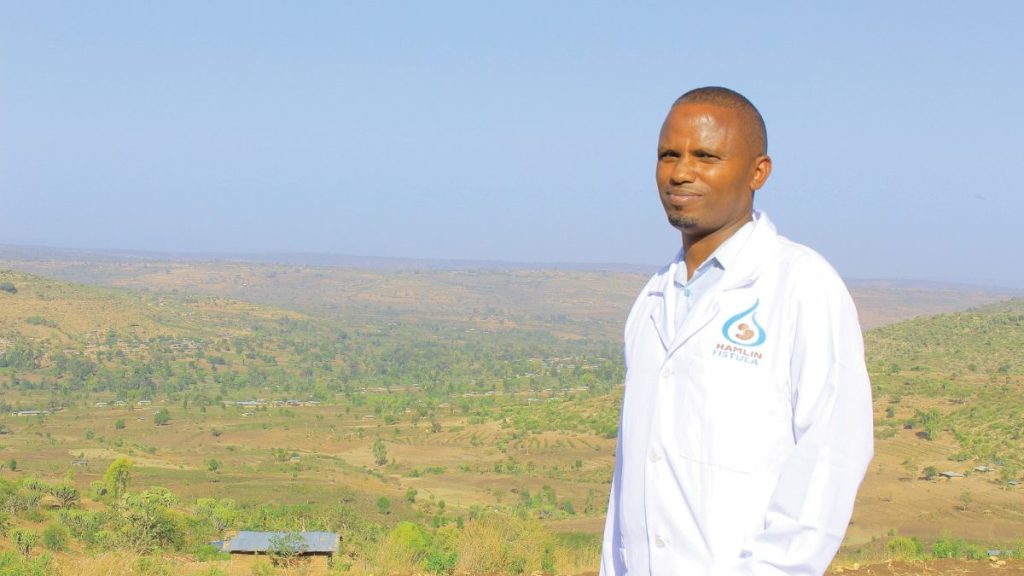Sekina has experienced heartbreaking loss and isolation. Thanks to Hamlin Fistula Ethiopia’s holistic approach to obstetric fistula treatment, Sekina has also been able to experience the joy of dryness and the dignity of having her health restored. Today, she is ready to rebuild her life with optimism and gratitude.
Life before fistula
Growing up, Sekina’s life had many challenges. She was born and raised in a rural village near Bedeno in eastern Harar. Sekina’s opportunities were impacted by the remoteness of her village and the limited access to essential services including transport, medical care and schooling. Sekina’s parents couldn’t send any of her six siblings to school and the village’s cultural aversions to formal medical care discouraged her family from ever visiting a nurse or doctor.
Entrenched social expectations also shortened Sekina’s childhood. Like many girls in her village, Sekina was, through an arranged marriage, wed at a young age. Shortly after her wedding, Sekina became pregnant; it was a scary and frustrating time for her. “My mom tried to comfort me all the way, guide me in how to prepare for the delivery. Everything seemed normal until that final day,” says Sekina.
Living between life and death
Like all the other women in her remote village, Sekina intended to deliver her baby from home, without a midwife. She was in labor for two long, painful days; exhausted from her endeavours, she was carried to the closest local hospital for help. Tragically, Sekina’s baby was delivered stillborn. Sekina’s obstructed labor was so serious that the doctors considered her lucky to still be alive after her ordeal.

The aftermath of Sekina’s agonizing labor laid further trauma for her: she was incontinent from an obstetric fistula injury during the labor. “When I woke up, I found myself lying on a soaked bedsheet and I felt ashamed of myself. The doctors insisted that I go home and come back again after a few months, but I declined and chose to continue staying at the hospital for a month, hoping to get better. That didn’t happen and I was taken home with a heavy heart and grief,” Sekina recalls.
For months Sekina was struggling in pain and ostracized from her community, as a result of the stigma and lack of information about fistula. Although Sekina’s ordeal was relatively short, its impact was significant: “For me, those three months with fistula felt like three long years. I have lived between life and death. Hidden from even my own family members and friends,” Sekina remembers.
A cure for Sekina
Despite the agony of her fistula injury, Sekina never gave up hope for a cure to her fistula. After months of indignity and pain, her hopes were restored when she heard about Hamlin Fistula Ethiopia from two different sources. First, Sekina’s grandfather told her of a former fistula patient he knew who had successfully been treated at Hamlin’s Addis Ababa Fistula Hospital. She then heard about how Hamlin could help treat her own fistula injury from a Hamlin Patient Identification Officer, Mohammed, in eastern Harar. Mohammed spoke with Sekina and identified the nature of her fistula injury, before recommending that she visit Hamlin’s Harar Fistula Hospital to undergo comprehensive, free treatment. Both instances highlight the importance of word-of-mouth in spreading news of effective treatment and spreading hope to women like Sekina.

Mohammed transported Sekina and two other fistula patients from her village and its surrounding areas. In an Hamlin ambulance, she traveled to the Harar Fistula Hospital. After being welcomed by hospital staff, Sekina began a two-week program, including pre-operative physiotherapy in preparation for her fistula repair surgery. The clinical team at Hamlin's Harar Fistula Hospital, including surgeon Dr Leta, provide best-practice fistula treatment. After a single fistula repair surgery, Sekina was left standing tall, completely dry and happy. For Dr Leta, the return to good health of patients, like Sekina, is such a joy: "The smile on the face of my patients when their dignity is restored is the best part of my job. It’s why I won’t stop until Ethiopian mothers can enjoy a safe pregnancy, delivery and life with their children."
Dignity restored
Overwhelmed with emotion, Sekina said: “I never thought the suffering would end in such a short time. With the extraordinary treatment I received at this hospital I regained my dignity as a woman. Thank you to the staff here: you are life-givers and thank you for your love and for the affection you showed us patients.”

Sekina’s identification, transport and full treatment were all provided free of charge thanks to the generosity of Hamlin supporters. The Hamlin Model of Care, which was pioneered by Dr Catherine Hamlin, outlines a holistic treatment model which cares for the patient as a whole. “The service here is full and free. I dressed in clean clothes, slept on clean bedsheets, was fed delicious meals, did rehabilitation training and learnt basic life skills. This is an incomparable and complete service that I never had or thought about,” she says.
With her dignity, health and wellbeing restored, Sekina wants to help other women like her who have suffered a fistula injury, by spreading the word of a cure: “I will become your ambassador for the rest of my life. I would also like to thank those people who support the hospital to do such life-changing work.”
Click here to help Hamlin find more women, like Sekina, and help them begin their journey back to health and dignity.